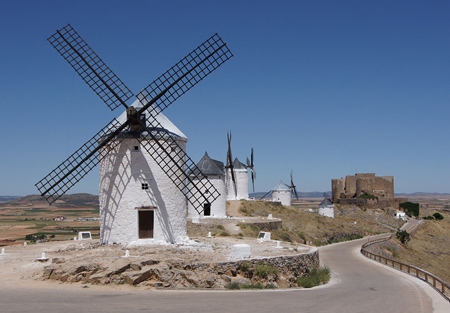Did you know that Spain produces more wine than most other countries of the world? Every year, they churn out over three million tons of the stuff. Only Italy and France manage to beat them in the wine production stakes. But where does it all go? Certainly not very much of it gets to Thailand, that’s for sure. In 2012, almost 50 percent of the wine made in Spain went to Germany, Great Britain, the USA and France. Even China managed to get its hands on about 4 percent of the total. But the number of Spanish wines available here in Thailand can probably be counted on the fingers of one hand.
Anyway, here are two Spanish wines worth seeking out. They’re both from the region known as Castilla, which occupies a huge area in the middle of Spain. Officially known as Castilla-La Mancha since 1978, it’s one of the most sparsely populated of Spain’s autonomous regions. The capital is the fine old city of Toledo with its two thousand years of history. During the Renaissance, Toledo became one of the most important artistic centres in Spain and the city’s outstanding fifteenth and sixteenth century architecture have brought it the status of a World Heritage Site.
 La Mancha – Don Quixote country (Photo: Jebulon)
La Mancha – Don Quixote country (Photo: Jebulon)
South of Toledo lies the largest plain in the Iberian Peninsula – La Mancha. It’s a massive, wind-swept place over 1,500 feet above sea level; yet it’s a potent symbol of Spanish culture with its vineyards, sunflowers, mushrooms, olive groves and of course, windmills. For this is the land of Don Quixote, the dotty hero created by the sixteenth century Spanish novelist, Miguel de Cervantes. And you’ll remember that the Castilla region was the scene of many historical battles between Christians and Muslims during the Middle Ages.
In parts of this high, hot and arid plain, the Airén grape thrives. If Spain had a National White Grape, it would probably be the Airén (i-REHN). It’s been around at least since the fifteenth century and today, in terms of planted area it’s the world’s Number One white grape. If you’ve never heard of it, this is probably because it grows nowhere else.
Castillo del Moro Airén-Sauvignon Blanc 2011 (white), Spain (Bt. 449 @ Wine Connection)
This wine is a very pale gold; a couple of shades lighter and it would be transparent.
It has an attractive, delicate floral aroma with pineapple and gooseberries up front and hints of fresh oranges. You may also notice that fresh grassy smell that tends to come with Sauvignon Blanc. The wine is very smooth on the palate but has a pleasing tang of apple-like acidity. It doesn’t have the toe-curling bitterness of some Sauvignons, and I can only assume that the Airén in the blend has successfully softened Sauvignon’s characteristic bite.
Nevertheless, it’s a light and refreshing wine, ample fruit on the palate and an attractive lingering finish with delicate hints of grapefruit. The wine is dry, but it’s not in the dinosaur bones class because there’s just a hint of sweetness to the taste. In many ways, this is a real charmer – an unassuming crisp wine that is a delight to drink. At just 12% alcohol content, it would make a lovely apéritif or you could enjoy it with seafood and salads. Perfect I’d say, for summer evening drinking.
Castillo del Moro Tempranillo-Syrah 2011 (red), Spain (Bt. 449 @ Wine Connection)
Spain’s National Red Grape would surely be the black, thick-skinned Tempranillo (tem-prah-NEE-yoh), which finds its greatest expression in wines of Rioja. Blended with Syrah (or Shiraz, as it’s sometimes known) this is a very dark, purplish red wine with a lovely delicate and slightly floral aroma of red fruit. There’s a delightful whiff of fresh raspberries, wax crayons, herbs and spices. The aromas are surprisingly interesting for a wine of this price and I felt I was actually sniffing something rather more expensive. There’s plenty of ripe, red fruit on the palate and the wine has a pleasantly soft mouth-feel, with virtually no acidity and just the hint of ripe tannins in the background.
Tempranillo tends to dominate both the aroma and the taste, so you’ll probably pick up flavours of raspberry, cherry and blackberry. It’s rather an elegant wine; light and dry with dash of spice and a long peppery finish that probably comes from the Shiraz in the blend. At 13% alcohol, it would make a charming and unobtrusive partner for many dishes. The makers recommend drinking it with tapas (which course, could be virtually anything) red meats and pasta.
As an experiment and in keeping with the Spanish theme, I tried pairing it with a home-made Spanish-style pizza, topped with Spanish Chorizo from Pamplona, some Spanish ham and even Spanish olives and capers. Honestly, I just hope you appreciate the trouble I go to on your behalf. It’s not everyone who would make the effort of cooking a pizza at the end of a hot and exhausting day.
The wine proved an excellent partner and if you get a chance to try these delightful Spanish wines, do give them a try. Oh yes, the pizza. My natural and rather charming modesty prevents me from admitting that the pizza was perfection itself. Even the dogs agreed.




